Artificial Intelligence-Steered Multi-Objective Design Augmentation for Yaw Bearing of Wind Turbine Electricity Generation Mechanism
DOI:
https://doi.org/10.61310/mjst.v22i2.2187Keywords:
genetic algorithm, JAYA algorithm, multi-objective optimization, wind turbine, yaw bearingAbstract
Unchecked rise in greenhouse gas emissions exacerbates global climate instability, leading to severe ecological disruptions, economic losses, and threats to human health and biodiversity. The sector of electricity is a prominent source of greenhouse gases. Power-generating companies may drastically lessen their fossil fuel consumption by exploring the use of renewable energy sources like wind power. Each year, a noteworthy amount of the functioning time of wind turbines remains unused because of mechanical breakdowns in various of its components. A crucial part of the wind turbine, the yaw bearing enables the wind turbine blades to remain in the correct alignment needed for efficient power generation. In this research, artificial intelligence methods such as the Genetic Algorithm and JAYA Algorithm have been exercised to augment the yaw bearing design. While the Bearing Frictional Torque has been taken into consideration for reduction, Basic Dynamic Axial Load Rating and Static Load Factor have been taken into account for expansion. The Multi-Objective Genetic Algorithm proves to be more advantageous than the Multi-Objective JAYA Algorithm in enhancing the wind turbine yaw bearing's operational dependability.










